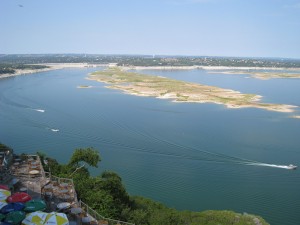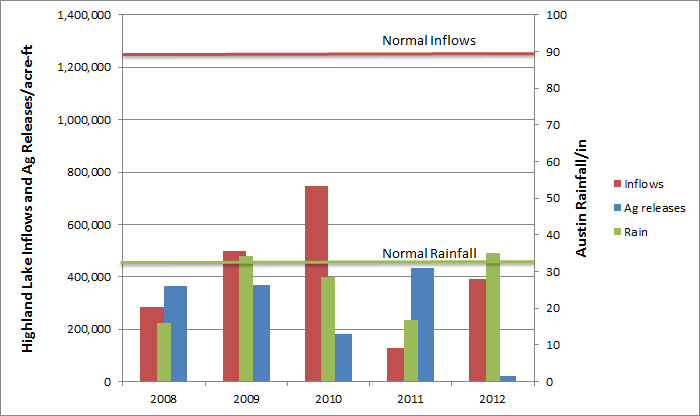Situational Awareness Key to Drought Management
By Danny D. Reible, Ph.D.
In 2011, Texas experienced the worst single-year drought in its history. Unfortunately, essentially all of Texas remains in a state of severe to exceptional drought. Many of the reservoirs remain at historically low levels, and the majority of Texas rivers exhibit flows well below normal (<25%ile). Drought conditions will ultimately ease but no one can state when or for how long.

Lake Travis on August 24, 2013.
So how do we manage this situation? We respond effectively by developing a sense of situational awareness of the drought and its potential consequences. We must build a resilient management system that can take advantage of water when it’s available but also capable of maintaining critical needs, such as water for drinking, the economy, and the environment, in the face of a drought that may continue for one, two, or even five or more years. We have to project forward in time potential drought and water use scenarios and use water prudently and cautiously recognizing that there is a finite possibility that water availability will remain limited. I would suggest that we were slow to realize the potential consequences of drought as it strengthened its stranglehold on Texas in 2011. We made decisions that presumed that rain would soon return, but despite some promising signs in 2012, we remain in drought.
Among the decisions that were made was the release of 433,000 acre-feet of water from the Highland Lakes of Central Texas for irrigation of rice in South Texas. This is approximately 50 percent more than the average of the previous three years and occurred in what turned out to be a year with the lowest Highland Lake inflows on record; inflows that were insufficient to even offset normal evaporation from the lakes. Thus, every drop of water released from the lakes in 2011 came directly from the lake reserves. In hindsight, a more modest release could have maintained significant reserves in the lakes and could have led to greater recreational, residential, and agricultural use of the water over the last two years. Instead, many businesses around the lake have suffered, recreational use has dropped, residential water use has been curtailed, and agriculture use has been largely shut down.

Highland Lake inflows and agricultural releases/acre-feet compared to Austin rainfall/in.
While easier to see in hindsight, there were warning signs that, if acted upon, might have allowed greater reserves in the lakes and led to more water for all users in the last two years. Very little rainfall was observed in the watershed in February through April of 2011; Austin rainfall was less than 15 percent of normal levels during that period. Stream inflows were similarly affected. While any three-month period does not provide much of an indication of climate trends, greater situational awareness and prognostic models would have suggested that there was a possibility that dramatic reductions in lake levels and reserves were possible if the low rainfall, inflows, and high releases continued. It would have been important to implement a more cautious release plan that could have been updated as new information became available. The management plan in operation at the time had no such capability, but the resulting lake conditions illustrate how important it is to be able to adaptively manage the system to mitigate the potential effects of drought. Would release of only enough water for a single rice crop in 2011 made it possible to have rice crops in 2012 and 2013 while retaining enough water in the lakes for other uses? It is difficult to say, but such an outcome would likely have been preferred for both upstream and downstream water users.
 Dr. Danny D. Reible is the Donovan Maddox Distinguished Engineering Chair at Texas Tech University. He served as program chair of the 2012 Texas Water Summit.
Dr. Danny D. Reible is the Donovan Maddox Distinguished Engineering Chair at Texas Tech University. He served as program chair of the 2012 Texas Water Summit.

